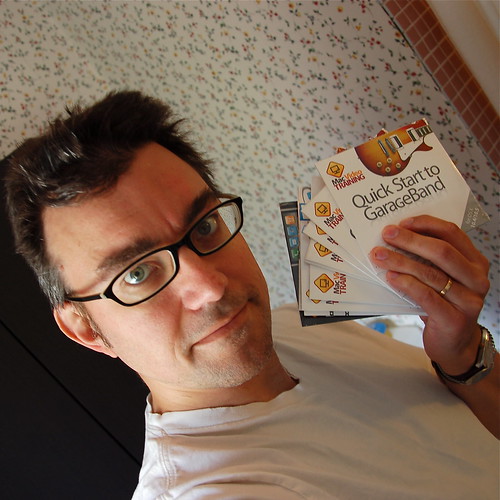Penmachine
17 November 2009
Help me win a People's Choice Podcast Award
 The podcast I've co-hosted since 2006, Inside Home Recording, has been nominated for a 2009 Podcast Award, in the Education category. We're up against some heavy hitters, such as Grammar Girl and The Skeptics' Guide to the Universe, so to have a chance of winning, I'm asking for your help.
The podcast I've co-hosted since 2006, Inside Home Recording, has been nominated for a 2009 Podcast Award, in the Education category. We're up against some heavy hitters, such as Grammar Girl and The Skeptics' Guide to the Universe, so to have a chance of winning, I'm asking for your help.
Simply go to PodcastAwards.com and choose Inside Home Recording in the Education category. (Feel free to pick any other shows in other categories too.) Then put your name and email address at the bottom and confirm your vote when it reaches your email box. Finally, if you can, please do it again tomorrow, and each day until voting ends on November 30. Each person can apparently vote once per day.
I'm not sure how good a shot we have, and the prizes aren't huge, but it would be fun to win. Thanks!
Labels: insidehomerecording, linkbait, podcast
19 October 2009
Links of interest (2009-10-19):
From my Twitter stream:
- My dad had cataract surgery, and now that eye has perfect vision—he no longer needs a corrective lens for it for distance (which, as an amateur astronomer, he likes a lot).
- Darren's Happy Jellyfish (bigger version) is my new desktop picture.
- Ten minutes of mesmerizing super-slo-mo footage of bullets slamming into various substances, with groovy bongo-laden soundtrack.
- SOLD! Sorry if you missed out.
I have a couple of 4th-generation iPod nanos for sale, if you're interested. - Great backgrounder on the 2009 H1N1 flu virus—if you're at all confused about it, give this a read.
- The new Nikon D3s professional digital SLR camera has a high-gain maximum light sensitivity of ISO—102,400. By contrast, when I started taking photos seriously in the 1980s, ISO—1000 film was considered high-speed. The D3s can get the same exposure with 100 times less light, while producing perfectly acceptable, if grainy, results.
- Nice summary of how content-industry paranoia about technology has been wrong for 100 years.
- The Obama Nobel Prize makes perfect sense now.
- I like these funky fabric camera straps (via Ken Rockwell).
- I briefly appear on CBC's "Spark" radio show again this week.
- Here's a gorilla being examined in the same type of CT scan machine I use every couple of months. More amazing, though, is the mummified baby woolly mammoth. Wow.
- As I discovered a few months ago, in Canada you can use iTunes gift cards to buy music, but not iPhone apps. Apple originally claimed that was comply with Canadian regulations, but it seems that's not so—it's just a weird and inexplicable Apple policy. (Gift cards work fine for app purchases in the U.S.A.)
- We've released the 75th episode of Inside Home Recording.
- These signs from The Simpsons are indeed clever, #1 in particular.
- Since I so rarely post cute animal videos, you'd better believe that this one is a doozy (via Douglas Coupland, who I wouldn't expect to post it either).
- If you're a link spammer, Danny Sullivan is quite right to say that you have no manners or morals, and you suck.
- "Lock the Taskbar" reminds me of Joe Cocker, translated.
- A nice long interview with Scott Buckwald, propmaster for Mad Men.
Labels: animals, apple, biology, cartoon, geekery, humour, insidehomerecording, iphone, ipod, itunes, linksofinterest, nikon, photography, politics, science, surgery, television, video, web
05 October 2009
Nominate our shows for the Podcast Awards?
 I'm the co-host of Inside Home Recording and engineer for Lip Gloss and Laptops, my wife's podcast. We're trying the usual social-media methods of garnering nominations for the annual Podcast Awards, which have been running for a few years now and are organized by Todd Cochrane of Geek News Central.
I'm the co-host of Inside Home Recording and engineer for Lip Gloss and Laptops, my wife's podcast. We're trying the usual social-media methods of garnering nominations for the annual Podcast Awards, which have been running for a few years now and are organized by Todd Cochrane of Geek News Central.
If you'd like to help out, here's what I'd ask you to do by the deadline of October 18, 2009:
- Please go to PodcastAwards.com.
- In the People's Choice and Health/Fitness categories, fill in Lip Gloss and Laptops and its URL, www.lipglossandlaptops.com.
- In the Best Produced and Education categories, fill in Inside Home Recording and its URL, www.insidehomerecording.com.
- Do not nominate either show for any other categories. Each show is only allowed two nominations (one of the top categories, and one regular one), and we don't want to be disqualified or to dilute the vote. (Inside Home Recording, for instance, is more likely to get a nomination in Education, because Technology is crowded with popular podcasts.)
- Feel free to fill in any other podcasts you like in other categories. But do it all at once, because you can only submit the ballot once per person.
- Add your name and email address to the bottom of the form (Todd has tremendous integrity—he's not going to sell or reuse your info).
- Check your form over, and submit it.
- Maybe tell your friends.
Remember, the deadline is October 18. I'll let you know when the actual voting begins after that, especially if either of our podcasts get in. And of course, please subscribe to the shows if you don't already!
Labels: insidehomerecording, linkbait, lipglossandlaptops, podcast
06 September 2009
Les Paul's legacy
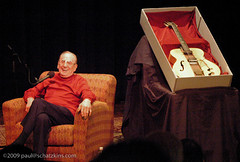 A few weeks ago I wrote about Les Paul, who died in mid-August at the age of 94. My podcast co-host Dave Chick and I decided that our next episode of Inside Home Recording would be a Les Paul special edition, dedicated to different aspects of Les's career, because as the inventor of multitracking and pioneer of solidbody electric guitars, he was so important to modern recording.
A few weeks ago I wrote about Les Paul, who died in mid-August at the age of 94. My podcast co-host Dave Chick and I decided that our next episode of Inside Home Recording would be a Les Paul special edition, dedicated to different aspects of Les's career, because as the inventor of multitracking and pioneer of solidbody electric guitars, he was so important to modern recording.
Tonight, we put that tribute episode (IHR #74, available as an enhanced AAC or audio-only MP3 podcast) online. In the process of putting it together, both Dave and I were astonished by how much Les Paul accomplished that we didn't even know about—most of it before we or any of our listeners were born.
I came to the conclusion, expressed in the our editorial at the end of the show, that Les was the single most important person in the history of modern recorded music—more important, on balance, than Thomas Edison or Leo Fender or Elvis or the Beatles or any of the other contenders.
You can listen to the show to find out if you agree. But it's indisputable that anywhere in the world where there is a microphone or a speaker, a Record button or a set of headphones—from every music studio or TV soundstage to every car stereo or iPod earbud, from every crummy punk dive bar to every high-end hip-hop nightclub, from the Amundsen-Scott outpost at the South Pole to the International Space Station—Les Paul played a part in making them what they are.
Labels: death, guitar, history, insidehomerecording, jazz, music, recording
17 August 2009
My video course now at London Drugs
Remember my GarageBand training video? The one you can buy from MacVideoTraining (with a 20% discount using the checkout promo code ihr)? This one?
It's now available online from London Drugs too, as well as on DVD in their stores here in Western Canada. Why not buy some copies for your friends (and enemies, for that matter)?
Labels: apple, education, insidehomerecording, itunes, paulgaray, recording, software, video
13 August 2009
Thank you, Les Paul
Cross-posted from Inside Home Recording...
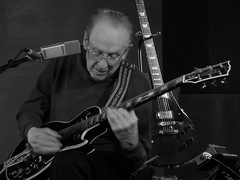 No one who performs popular music, or records music of any kind, hasn't been affected by Les Paul, the legendary guitarist, musical innovator, and inventor who died today at age 94.
No one who performs popular music, or records music of any kind, hasn't been affected by Les Paul, the legendary guitarist, musical innovator, and inventor who died today at age 94.
Many people know him only for the solidbody electric guitar that bears his name—indeed, he hand-built his own solidbody electric years before that, but Gibson was uninterested in the design until rival Fender successfully sold similar concepts in the early 1950s. Still, Paul was not only a talented and prolific player (who continued a regular live gig in New York until very recently), but also a hit-making jazz and pop artist, as well as the inventor of multitrack recording and overdubbing, as well as tape delay and various phasing effects:
He was a constant tinkerer, heavily modifying even his own Les Paul guitars with customized electronics and switching, and often acting as his own producer, engineer, and tape operator. Every listener to Inside Home Recording, and every musician or recording enthusiast today, owes him a massive debt, and we'll all miss his talent and contributions.
Labels: death, insidehomerecording, jazz, music, recording
05 July 2009
Links of interest 2006-06-28 to 2006-07-04
Once again, while I'm on my blog break, my edited Twitter posts from the past week, newest first:
- Photo of Obama picking up his infamous housefly victim.
- Guess that U2 iPod is never coming back.
- And now: "Ant and Buttercup," my debut HD macro closeup movie from our summer garden:
- My first experiments with off-camera flash during close-up photography:










- If I'm passed at high speed by someone with a Washington plate BOKEH, I now know who it is. He says he'll wave.
- Mammals will play, even between species, even when you'd never expect it—wild polar bear and huskies (slide show via Dave Winer).
- A couple of crows are nesting nearby; they keep landing in our birdbath and on the house and lamp stands, looking ominous. Too smart, crows.
- Sitting in a B.C. garden
No waiting for the sun - CompuServe finally shuts down.
- Just in case you're looking for a $2.1 million convertible.
- Congratulations to Buzz Bishop, Jen, and Zacharie.
- I presume this tiny USB-driven monitor screen is Windows-only, because of drivers? Looks pretty swell. (Via Neal Campbell.)
- Definitive proof I'm not afraid of heights: I love this idea.
- Via John Biehler, I found that as well as MythBuster Adam Savage, his co-workers Grant Imahara and narrator Robert Lee are also on Twitter.
- When I had my first Nikon 25 years ago, I wouldn't have believed I'd ever own one (a D90) with 66 pages of the manual (out of a couple hundred total, in a 16 MB PDF file) just for menu options. Then again, 25 years ago, a friend showed me a shoulder-mounted Betamax camera from Hong Kong, and it was the latest in high tech video too.
- That's the funkiest beat I've ever heard a marching band play (via Jared Spool). Maybe some James Brown next?
- Has anyone pinpointed the exact day that Victoria Beckham stopped being able to smile? Angus Wilson speculates, "whatever day she began to look less like a hot English babe and more like a velociraptor."
- Meg Fowler: "Sarah Palin's quitting politics like Ann Coulter's quitting evil."
- As the 40th anniversary of the first moon landing approaches, some fabulous photos from the missions, via Bad Astronomy.
- From Ben Englert: "Thank you, gdgt, for institutionalizing the arduous task of dick-measuring by figuring out who has more toys."
- Ten best uses of classical music in classic cartoons.
- Our fridge magnet: "I love not camping."
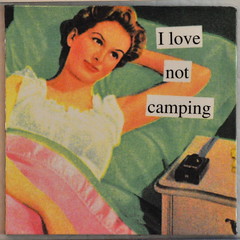
- How did I manage to bite the inside of my upper lip while eating a peach? If this were high school, the guys would say, "Each much?"
- Back to short hair for summer. And now I realize that it's Colbert hair.
- I think my guts have calmed down now. Time for bed. In the meantime, enjoy a naked Air New Zealand flight crew.
- In case you'd like to watch Jeff Goldblum reporting on his own "death," on Colbert Monday: links for Canada and the U.S.A. (sorry if you're elsewhere!).
- Didn't attend various Canada Day parties because of tired family and my usual intestinal side effects. Hope you had fun in my stead. Managed to avoid intestinal chemo side effects for a few days, but they're back with a vengeance. Could be a looooong night. (And it was. At 2 a.m., my chemo side effects were "over" and I went to bed. Bzzt! Wrong! Finally got to sleep at 9 a.m., woke up at 1 the next afternoon. As Alfred E. Neuman says, Yecch.)
- Whatever you think of the 2010 Olympics here in Vancouver, VANOC is doing a good job with graphic design.
- I, too, welcome our new ant overlords.
- I had no alcohol on my birthday yesterday, but still had a Canada Day headache on July 1. Here's my new free instrumental.
- Inside Home Recording #72 is out: Winners, Studio Move, Synth 101, Suckage! AAC enhanced and MP3 audio-only versions.
- Normally I really like our car dealer's service dept, but today the steering wheel came back oh-so-slightly to the left. They had to re-fix it.
- World's geekiest pillows (via Chris Pirillo). My guess: they didn't license the Apple icons. Get the pillows while you can.
- Officially made it to 40. Thanks everybody for the birthday wishes. Most people are bit melancholy to reach 40, but I am extremely glad to have made it.
- Just returned from a Deluxe Chuck Wagon burger (with cheese) at the resurrected Wally's Burgers in Cates Park, North Vancouver:
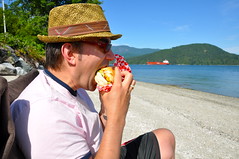
- From Rob Cottingham: "The hell with putting a ring on it. If you liked it, you shoulda made a secure offsite backup."
- Info about recording old vinyl records into a computer: You need a proper grounded phono preamp, with good hot signals into an audio interface or other analog-to-digital converter. A new needle might be wise if yours is old, but the real phono preamp (w/RIAA curve) is the most necessary bit after that. Route it thru an old stereo tuner if needed! See my old post from 2006 at Inside Home Recording.
- Myth confirmed: Baby girl evidence (named Stella) shows MythBusters' Kari Byron actually was pregnant.
- My new Twitter background image is the view we saw at sunset during my birthday party on Saturday. (I've since replaced it again.)
- Back from another fun sunny summer BBQ at Paul Garay's new house—it's been a burgers-n-beer weekend.
- Photos from my 40th birthday party now posted (please use tag "penmachinebirthday" if you post some).
Labels: animals, band, birthday, cartoon, family, food, geekery, insidehomerecording, linksofinterest, moon, movie, music, mythbusters, news, paulgaray, photography, politics, space, transportation, usb
27 May 2009
Learn GarageBand from me on DVD
My Quick Start to GarageBand video course from MacVideoTraining (a company co-founded by my former podcasting partner Paul Garay) is now available on DVD:
You can get it at London Drugs and many other retailers in North America, or if you use the promo code ihr, you can get a 20% discount if you buy a DVD or download online. The discount code also works for John Biehler's iTunes course and other stuff from MacVideoTraining, including bundles.
Labels: apple, education, insidehomerecording, itunes, paulgaray, recording, software, video
05 May 2009
Flutebox and Beardyman
[Cross-posted from Inside Home Recording (IHR).]
We've highlighted some fine beatboxers at IHR over the years, but these two (Flutebox and Beardyman, from the U.K.) are the best I've ever seen:
There's so little technology here (two mics, two voices, and a flute), such a performance could theoretically have happened 50 years ago, but no one would have thought of it. Eighteen minutes may seem awfully long for a web video, but I promise you'll be mesmerized. It's worth watching all the way through.
Labels: band, insidehomerecording, music, video, youtube
10 April 2009
My review of GarageBand '09
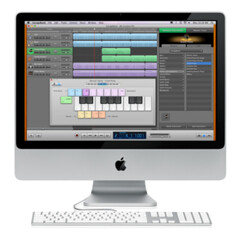 Over the past year, I've put myself forward as something of an expert on GarageBand, Apple's intro-level audio recording and podcasting application. I've been using the program intensively, through every version upgrade, since it first appeared in 2004, and I've kept in touch with Apple (through both formal and informal channels) about it ever since.
Over the past year, I've put myself forward as something of an expert on GarageBand, Apple's intro-level audio recording and podcasting application. I've been using the program intensively, through every version upgrade, since it first appeared in 2004, and I've kept in touch with Apple (through both formal and informal channels) about it ever since.
Plus you can now buy a comprehensive video course I recorded to show you how GarageBand works.
So you might wonder what I think of Apple's newest version of the program. If so, I've just published a big GarageBand '09 review article over at the Inside Home Recording blog, which should interest you. There's also a link to my audio review from a couple of weeks ago.
Labels: apple, education, insidehomerecording, music, podcast, recording, review, software
08 April 2009
Yes, master
There's been a bit of hype over the new re-mastering of the Beatles music catalogue, for a new set of CD releases and a Beatles version of Rock Band coming in September. The press release says that Apple Corps. (the Beatles record companies) are:
...delighted to announce the release of the original Beatles catalogue, which has been digitally re-mastered for the first time...
(My emphasis.) That's a marketing lie. The catalogue was digitally re-mastered in 1987 for the first CD releases. It had to be. You can't make a CD (or any other digital music medium) out of analogue audio without digitally re-mastering it first. Unless EMI and Apple Corps. consider the 1987 occasion the "first digital master" and the new ones the "first digital RE-master," which is a "that depends on what your definition of 'is' is" kind of semantic distinction.
What are mastering and re-mastering?
Mastering is the phase of audio production where you prepare audio files for their final medium. In the days of LPs, mastering engineers evened out the levels of different songs so their average volume didn't vary too widely, then applied various types of equalization to the master tapes, designed for the way record players were manufactured, and to prevent heavy bass frequencies from causing the needle to hop out of the grooves. Setting standards for those masters were one of the things the Recording Industry Association of America used to do before it turned to suing its customers for file sharing.
There would need to be different masters for cassettes or eight-track tapes, by the way.
Engineers mastering for CDs didn't have to worry about the groove hopping, but for music recorded on analogue equipment (i.e. tape machines), they did have to digitize it into ones and zeroes using what's known as an A/D (analogue-to-digital) converter, as well as still making sure the various songs were of comparable average volume. That's the digital re-master.
Digital and analogue masters
These days pretty much everything is recorded digitally, either directly in a computer or by digitizing signals from microphones and guitar cables right at the source, so for new recordings the digital master is the first one. Re-mastering might be done later to make it sound different—or, with a bit of irony, to convert it to analogue for special LP pressings or DJ vinyl singles. That would be an analogue re-master.
So it's true that these new Beatles CDs (and, with luck, eventually iTunes tracks) will be new digital re-masters, but they won't be the first ones. If you already have a complete collection of Beatles CDs from those 1987 digital re-masters, these new ones will probably sound different, maybe better. But they could sound worse.
Avoiding the Loudness Wars
The trend in the past decade has been to master or re-master pop recordings to sound way too loud, and to crush all the dynamics (the difference between the loud and soft parts) out of songs. That's why listening to a top-hits radio station, or a playlist of current top pop hits, can actually be physically exhausting. Your ears never get a break. It's called the Loudness Wars, and we've talked about it a lot at my Inside Home Recording podcast. While it has seen a bit of a backlash recently, the risk is that EMI's engineers might have succumbed to the trend.
It happened a few years ago, when Genesis released re-mixed and re-mastered versions of many of their albums (even in surround sound). The audio compression wasn't especially extreme, and the re-mastering was useful for some very early recordings and bootlegs with poor sound quality, but many of the band's well-known albums from the '70s and '80s sounded too modernized—and, for die-hard fans, simply wrong, almost like cover-band versions of the tracks, or the "Greedo shoots first" special editions of the Star Wars movies.
I haven't heard the Beatles results yet, but I find it encouraging that EMI has also gone to the trouble of making new mono re-masters of the Beatles catalogue as part of the current set. If they're willing to be that retro, I suspect they've probably avoided over-compressing the stereo mixes too. I sure hope so.
Labels: band, controversy, geekery, insidehomerecording, music
31 March 2009
IHR and LGL posted for March
My wife Air and her co-host KA have posted Lip Gloss and Laptops #132, and my co-host Dave and I have published Inside Home Recording #69 (dude).
The shows cover GarageBand '09, Simply Ageless Foundation, different types of audio delay, Barry M Cosmetics, too much Nickelback, and Rejuvelash Natural Declumping Lash Exhilarator. I'll let you guess which podcast addresses which products.
Labels: insidehomerecording, lipglossandlaptops, podcast
24 March 2009
I made a goofy little metal video
Paul Thurrott and Leo Laporte have used my tune "More Red Than Red" as theme music for their Windows Weekly podcast since 2006. But on their latest episode, they thought about maybe replacing it with the title track from the album "Enigma," by Microsoft's retired chief of Windows development (and longtime guitarist) Jim Allchin. So I tried to dissuade them at the Penmachine Podcast:
The "Turrican Van Halen" reference is part of the Windows Weekly show—it refers to the old Commodore 64/Atari/Amiga game "Turrican."
I made this available as Inside Home Recording TV Episode #5. You can also download it (H.264 video) or watch it at Viddler, Blip.tv, Facebook, YouTube, and Vimeo. Licensed for you to share and reuse, as long as you give me credit.
Labels: insidehomerecording, leolaporte, music, penmachinepodcast, podcast, video, windows
22 March 2009
Get 20% off my GarageBand video course
A few months ago I recorded a big series of more than 50 short instructional videos for the Quick Start to GarageBand course at MacVideoTraining.com, a new video training company co-founded by my former Inside Home Recording (IHR) podcast co-host Paul Garay. Some of their other training DVDs are available at lots of retailers throughout North America.
However, if you want a better deal, you need to do it online. You can buy my course, or one of several others from the company, with a 20% discount on any single video or bundle, through a new affiliate program at IHR. Just go to insidehomerecording.com/mvt and enter the coupon code ihr at checkout.
Labels: apple, education, insidehomerecording, music, podcast, recording
16 January 2009
Links of interest (2009-01-16):
- Some photographers buy old lenses (even manual focus, manual aperture lenses) for their brand new cameras. Here's why.
- This no-knead bread is apparently ridiculously easy, all the rage, and quite time-consuming to make.
- Darrell Fandrich lives near Seattle. He takes cheap Chinese pianos, puts a lot of work and experience into them, and creates a great piano, like "upgrad[ing] a Hyundai to run like a Bentley, for the price of a Honda."
- How to use Photoshop Elements 6 (which I don't own) to merge several mediocre group photos into a single good one.
- Since I have cancer, several people have told me (and told me, and told me) about DCA and essiac tea—among dozens of other potential cures and treatments. As I said about DCA a couple of years ago, I'm still going with the evidence, and it's not yet there for those particular treatments.
- Darren is a little frustrated with iTunes on his PC. And he draws a very cute sea kitten (actually, I guess it's probably a freshwater variety, so it would be, what, a pond kitten?).
- My latest camera collage is up to 8700 views, 43 comments, and 67 favourites on Flickr. Its predecessor from June has passed 41,000 views, 82 comments, and 217 favourites. And my original version from December 2007 has reached 11,500 views, 109 comments, and 39 favourites. Yep, we nerds love our camera porn.
- We've posted the first episode of the Inside Home Recording podcast for 2009: there are enhanced (pictures and links) and MP3 (audio only) versions, plus a separate full unedited half-hour interview with Peabody Award–winning producer Paolo Pietropaolo from CBC Radio.
Labels: cancer, food, insidehomerecording, itunes, music, photography, podcast, radio, science, software
21 December 2008
Free MP3 song: "Vitamin Yummy"
When I put together the GarageBand video course that Mac Video Training is now selling, I of course had to construct a song using the program. I had no plan in advance, so as I worked my way through the various videos the tune sort of assembled itself into a weird little song I ended up calling "Vitamin Yummy" (3 MB MP3 file):
- Download "Vitamin Yummy" (2 min 30 sec)
It's silly, and I'm not even sure what style to call it, but there you go. As usual, it's available under a Creative Commons license so you can share it around. I'm also not sure if this song qualifies for the Miss604 iTunes Giveaway either, but I'll enter it anyway.
Labels: apple, free, guitar, insidehomerecording, music, penmachinepodcast, software, video
18 December 2008
Last IHR of 2008, GarageBand training, mention at TidBITS
 Those of you who listened to my classical guitar recording of "What Child Is This?" yesterday might be interested in how I recorded it. I describe that in episode #65 of Inside Home Recording (IHR), our last one for the year. My bit starts about 36 minutes in, but there's lots of interesting stuff in the rest of the show too.
Those of you who listened to my classical guitar recording of "What Child Is This?" yesterday might be interested in how I recorded it. I describe that in episode #65 of Inside Home Recording (IHR), our last one for the year. My bit starts about 36 minutes in, but there's lots of interesting stuff in the rest of the show too.
On a similar instructional note, over the course of several weeks this fall, when I was feeling well enough, I recorded almost 60 short instructional videos about how to use Apple's GarageBand audio software. They now form the Quick Start to GarageBand '08 course from Mac Video Training, a company co-founded this year by my former IHR co-host Paul Garay and Mike Kaye from Switching to Mac. The complete course costs $30 USD (about $40 Cdn these days) for download, and will be available on DVD in stores in the new year. (Earlier DVDs by different instructors are already at shops like London Drugs.)
Here's the introductory video:
Finally, the fine folks at TidBITS, a Mac-focused online newsletter that's been publishing since before the Web was invented (really!), have highlighted my Camera Works series here on some technical aspects of cameras and photography. I've written for TidBITS in the past, and it's a great resource you should all subscribe to. I can't even remember how long I've been reading it, but every issue teaches me something.
Labels: apple, guitar, insidehomerecording, paulgaray, photography, software, tidbits, video
06 December 2008
My friends at work know me well
While my cancer treatment means I haven't been able to work for my employer, Navarik, for close to two years, I still make time to attend a few company events, including the Christmas party last night in downtown Vancouver:
This year my colleague Nathan and his wife had an excellent idea for our traditional employee gift exchange: instead of getting each other trinkets, we were to imagine what our assigned recipients would have liked when they were children. They would get to open the wrapping in front of everyone at the party, then say whether the choice would have worked for their childhood selves. Now that the unwrapping is over, Navarik will donate all the presents to a children's charity for Christmas. Perfect!
Even more perfect? Whoever was matched with me gave my childhood self a matching set of a toy camera with a toy microphone. How about that?
Labels: friends, holiday, insidehomerecording, navarik, photography, recording, vancouver
06 November 2008
Audio of my CBC interview
If you missed my interview on CBC Radio earlier today, I have an MP3 file of it available now (5.2 MB, about 12 minutes). I spoke with host Stephen Quinn about all the drastic stuff I've been through since June 2007, including my major surgeries and several chemotherapy regimes, as well as the new phase of my cancer treatment, that of living with the disease rather than simply trying to destroy it.
Incidentally, I had intended on publishing the audio to my Penmachine Podcast too, but Apple's iWeb software, which I use for that, has a nasty bug that's been around since April, and which doesn't seem any closer to being fixed. It prevents me from updating the podcast without a lot of extra work, so I think I'll just plan to switch over to a less awkward podcasting tool in the near future. I'll let you know when that happens—and I'll have some new original music to post there too.
Finally, a new episode of Inside Home Recording should be online tomorrow too.
Labels: apple, cancer, cbc, ego, insidehomerecording, podcast, radio, software, web
31 August 2008
Cool retro juke box gear that's older than me
 If you're into audio gear, you'd like my father's house, especially his basement. Juke boxes used to be the thing, and he installed many of them in the '60s and '70s throughout British Columbia. My parents' rec room includes juke boxes for both 331/3 rpm LPs and 45 rpm singles.
If you're into audio gear, you'd like my father's house, especially his basement. Juke boxes used to be the thing, and he installed many of them in the '60s and '70s throughout British Columbia. My parents' rec room includes juke boxes for both 331/3 rpm LPs and 45 rpm singles.
Even cooler, my dad can hook up his MP3 player to one of them, and also route sound to some ancient but still great-sounding twin speakers, each of which comprises double 15-inch woofers (!) and exponential horn tweeters. Those can be extremely loud. Somehow I doubt that many people's current 5.1 surround sound systems will still be going strong in 40 years like these are.
Labels: audio, family, insidehomerecording, retro
22 August 2008
Happy birthday, IHR
The podcast I co-host, Inside Home Recording, turned three years old today. That's pretty old for a podcast.
Labels: anniversary, audio, birthday, insidehomerecording, podcast
14 June 2008
Getting good sound on your audio podcast
I co-host Inside Home Recording, a long-running audio podcast about recording music and other stuff in your home or project studio. Earlier this year we launched InsideHomeRecording.tv, a companion video podcast that offers short tutorials on the same subject. I just put together my first episode, which shows the process I use for my wife's podcast, Lip Gloss and Laptops, to get good sound reasonably efficiently and cheaply:
You can download IHR TV #3 (H.264 video) or watch it at Blip.tv, Vimeo, and Viddler. A shorter version is also on Revver, YouTube, MySpace, and Facebook. You can receive IHR and IHR TV updates at twitter.com/ihr. And you can subscribe to either the original IHR audio show or to IHR TV.
Let me tell you, though, video is hard. I constructed this episode using a combination of Final Cut Express (to import high-definition video from our AVCHD camcorder) and iMovie '06—which is an old version of that program—for editing. There was lots of importing and exporting, syncing and chopping up and reassembling, and general mucking around with stuff to get it to something I liked.
The reason I undertook such a convoluted process is that Final Cut Express is a big, hairy, complicated program. It does more than I need, and is nearly impossible to sit down and figure out by using it, while the "re-imagined" new iMovie '08 is too simple, designed with a minimalist set of features for absolute video beginners, which even I am not. But iMovie '06 is the perfect mix for me. Even so, it took hours and hours to put the episode together.
My next one will come together faster, because I've figured out some stuff, but I have a new respect for people who make videos, TV shows, and movies for a living—especially editors.
Labels: audio, editing, insidehomerecording, lipglossandlaptops, podcast, video
03 April 2008
Farewell to the Lab
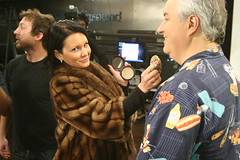 Back in February when my podcast co-host Paul and I made our most recent trip down to the Lab With Leo studios here in Vancouver, no one knew that it would be the last shooting week ever for the show. But not long afterwards, Leo Laporte emailed to tell us it was the end of the line: after ten years of creating Call for Help and The Lab for TV in the U.S. and Canada, it had been cancelled.
Back in February when my podcast co-host Paul and I made our most recent trip down to the Lab With Leo studios here in Vancouver, no one knew that it would be the last shooting week ever for the show. But not long afterwards, Leo Laporte emailed to tell us it was the end of the line: after ten years of creating Call for Help and The Lab for TV in the U.S. and Canada, it had been cancelled.
It's a pity that a tech show like The Lab, which covers a wide variety of topics and doesn't talk down to its audience, couldn't survive—or even get U.S. distribution. Fortunately, Leo (who has been covering technology on radio and TV for decades, and has even won an Emmy award) isn't standing still, and plans to launch an online version of the show in the next few weeks from his studio in Petaluma, California (also, incidentally, the town where Mesa-Boogie manufactures its guitar amplifiers).
As far as Inside Home Recording goes, we've started posting tutorials over at IHR TV, which may later include some live-action explanatory episodes like our segments on The Lab. And though it's far less convenient than driving a few minutes across Vancouver, if we ever find ourselves in California wine country, we might appear on Leo's new show down there too.
Labels: geekery, insidehomerecording, labwithleo, leolaporte, paulgaray, podcast, television
